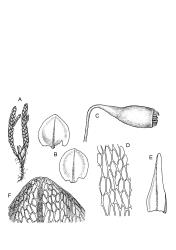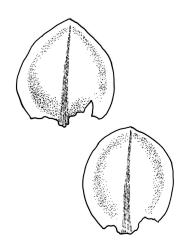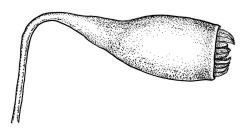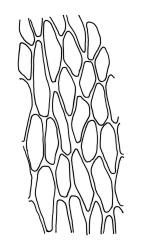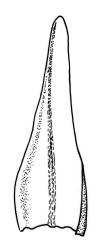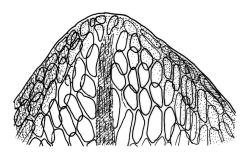- ≡ Anomobryum harriottii (R.Br.bis) Dixon, Bull. New Zealand Inst. 3: 202 (1926)
- = Anomobryum densum Dixon, Bull. Torrey Bot. Club 42: 103 (1915)
Plants yellow- or brown-green, forming loose turves. Stems julaceous, green or brown below, mostly c. 5–8(–10) mm, branching by subpericheatial innovation, simple or forked above, beset below with dark brown, strongly papillose rhizoids, in cross-section with firm-walled cortical cells and central strand weak or absent. Leaves evenly spaced and ± uniformly sized on stem, imbricate when moist, little altered when dry, broadly ovate (and then rounded at apex) to nearly cochleariform, c. 0.6–1.0 × 0.4–0.6 mm, strongly concave, pale- or brown-green, entire, lacking border, and plane at margins, not decurrent; upper laminal cells rhombic-hexagonal, incrassate, 21–30 × 10–12 µm and c. 2–3:1, smaller at apex and larger (to c. 60 µm) in lower leaf; marginal cells not differentiated; basal cells not pigmented. Costa rather broad at base, tapered, brown or red-brown at base, subpercurrent. Brood bodies (including tubers) absent.
Sexuality unknown (but frequently fruiting). Perichaetia near base of plant; perichaetial leaves ± lingulate, enlarged, c. 1.0–1.2 mm. Perigonia not seen. Setae 12–25 mm, red-brown; capsules inclined or horizontal, narrowly clavate or pyriform, (2.5–)3–4 × c. 1 mm, with a well-defined neck nearly ½ the total capsule length and wrinkled when dry; operculum lowly conic, not apiculate. Exostome teeth yellow-brown, bordered; endostome with narrow, perforate segments ± equal the teeth in length, and cilia rudimentary or absent. Spores 22–30 µm, yellow-brown.
Brown 1899, pl. 41, fig. 30; Dixon 1915, pl. 9, fig. 9 (as Anomobryum densum); Ochi 1970, fig. 18; Seppelt 2004, fig. 39; Spence & Ramsay 2006, fig 38, G–K.
There are no other species of Bryum in N.Z. with which B. harriottii could be easily confused, given its julaceous stems and strongly concave, nearly cochleariform leaves. Bryum funkii, a rarer plant with likewise small and imbricate leaves, is a paler plant with acute leaf apices and mostly excurrent costae. Ochiobryum blandum has leaves of similar shape but is a much larger plant with ± bordered, larger leaves. Ochiobryum blandum is usually strongly pigmented (red or black), lustrous, and grows in more aquatic situations than the present species.
NI: Gisborne (Mōkau Falls, Makaretu River, Te Waipuhake Stream), Hawke's Bay (Waikari Gorge), Wellington (Taihape, Ruahine Range); SI: Nelson (Mt Mytton, Mt Owen), Marlborough (Branch River), Canterbury (Mt Torlesse, Cass, Broad Stream, Rough Creek), Westland (Paparoa Range, Ōtira Gorge, Franz Josef), Otago (Pigroot Creek); A. Recorded from M by Seppelt (2004).
Australasian. Recorded from Tasmania by both Seppelt (2004) and Spence & Ramsay (2006).
On irrigated rock (greywacke, limestone, papa), most commonly at stream margins and also in seepages on vertical rock faces. On South I. ranging from c. 500 to c. 1350 m. Most frequent associates are Dicranella cardotii and Bryum laevigatum, and occasionally Blindia magellanica, Bryum clavatum, Cratoneuropsis relaxa, and Tridontium tasmanicum.
The present species was placed by Dixon (1926) in the genus Anomobryum Schimp., which is recognised in some modern floras (e.g., Smith 2004). Ochi's (1992) placement of Anomobryum as a subgenus within Bryum is followed here. In overall gametophytic habit B. harriottii is not distinguishable from the widespread northern hemisphere B. filiforme, but it differs in a number of sporophytic features, including the nature of its endostomal cilia.
There is a problem with the typification of the name B. harriottii R.Br.bis. The Weka Pass specimen labelled as "Bryum harriottii sp. nov." by Brown (CHR 335144) contains the pottiaceous moss Tetracoscinodon irroratus (Hook.f.) R.H.Zander with a few fruiting plants of B. clavatum. Ochi (1984, p. 182) stated that CHR 335144 "cannot be accepted as the type" of B. harriottii and had previously noted that "no type material of B. harriottii was available from European herbaria" (Ochi 1970, p. 35). I concur with Ochi's conclusion that neither element in the Weka Pass specimen conforms to Brown's protologue and that it cannot be considered as the holotype of B. harriottii; it is likely that a labelling error has occurred, most likely by Brown himself. The citation of the Weka Pass (Canterbury L.D.) collection as the holotype by Spence & Ramsay (2006, p. 285), who apparently did not see the specimen, is not correct.
However, both Brown's description and illustrations suggest that the plant used in preparing the protologue was consistent with the concepts of B. harriottii used by later authors (Dixon 1926, p. 202; Sainsbury 1955, p. 269).
Thus, it is concluded that "no original material is extant" (International Code of Nomenclature, McNeill et al. 2012, Art. 9.7). Two courses of action are available: to declare a neotype for B. harriottii R.Br.bis or to consider B. harriottii a nom. dub. and to employ a later, validly published name for the taxon. The latter option would necessitate undesirable name changes, since a combination in Bryum based on the only other validly published name (Anomobryum densum Dixon) would create an illegitimate homonym. Selection of a neotype using a Brown collection from Canterbury L.D. is deemed the best option conforming to the ICN and this is done above.




